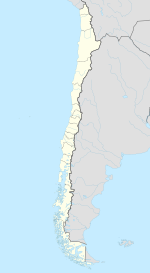Hualqui
| Hualqui | ||||||
|---|---|---|---|---|---|---|
| City and Commune | ||||||

Mirador of Hualqui, formerly the colonial fortress
|
||||||
|
||||||
| Coordinates (city): 36°57′36″S 72°55′48″W / 36.96000°S 72.93000°WCoordinates: 36°57′36″S 72°55′48″W / 36.96000°S 72.93000°W | ||||||
| Country | Chile | |||||
| Region | Bío Bío | |||||
| Province | Concepción | |||||
| Government | ||||||
| • Type | Municipality | |||||
| • Alcalde | Ricardo Fuentes Palma (Ind.) | |||||
| Area | ||||||
| • Total | 530.5 km2 (204.8 sq mi) | |||||
| Elevation | 39 m (128 ft) | |||||
| Population (2012 Census) | ||||||
| • Total | 22,892 | |||||
| • Density | 43/km2 (110/sq mi) | |||||
| • Urban | 14,756 | |||||
| • Rural | 4,012 | |||||
| Sex | ||||||
| • Men | 9,293 | |||||
| • Women | 9,475 | |||||
| Time zone | CLT (UTC−4) | |||||
| • Summer (DST) | CLST (UTC−3) | |||||
| Area code(s) | 56 + 41 | |||||
| Website | Municipality of Hualqui | |||||
Hualqui (Spanish pronunciation: [ˈwalki]) is a Chilean city and commune in the Concepción Province, Biobio Region. It is also part of the Greater Concepcion conurbation, although it maintains a rural profile. It had a population of 22,892 inhabitants according to the 2012 census.
Its name comes from the Moluche Aillarehue and rehue of Hualqui that existed there at the beginning of the Conquest of Chile. In 1577, the Royal Governor of Chile Rodrigo de Quiroga erected a small fort of Hualqui on the Biobío River 23 km (14 mi) from the city of Concepcion and 24 km (15 mi) to the northwest of Talcamávida at the site of the modern city and over time a small settlement grew around it. In the beginning of 1756 Governor Manuel de Amat y Juniet erected a town there, named San Juan Bautista de Gualqui. It served as capital to the Corregimiento de Puchacay and then Partido de Puchacay until 1799.
According to the 2002 census of the National Statistics Institute, Hualqui spans an area of 530.5 km2 (205 sq mi) and has 18,768 inhabitants (9,293 men and 9,475 women). Of these, 14,756 (78.6%) lived in urban areas and 4,012 (21.4%) in rural areas. The population grew by 16.2% (2,612 persons) between the 1992 and 2002 censuses.
...
Wikipedia




